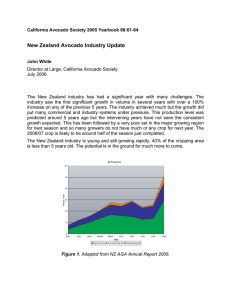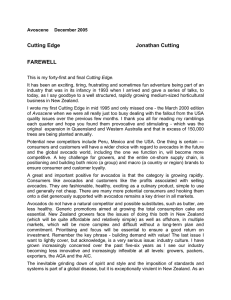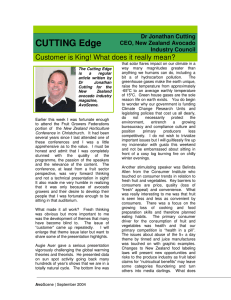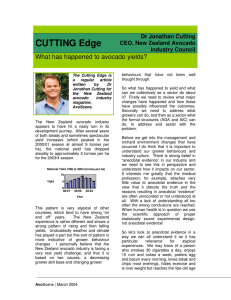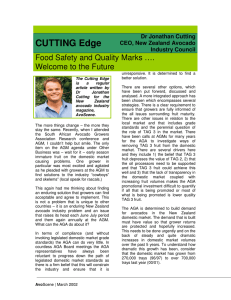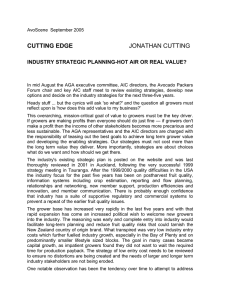CUTTING Edge Rubber Hits the Road!
advertisement
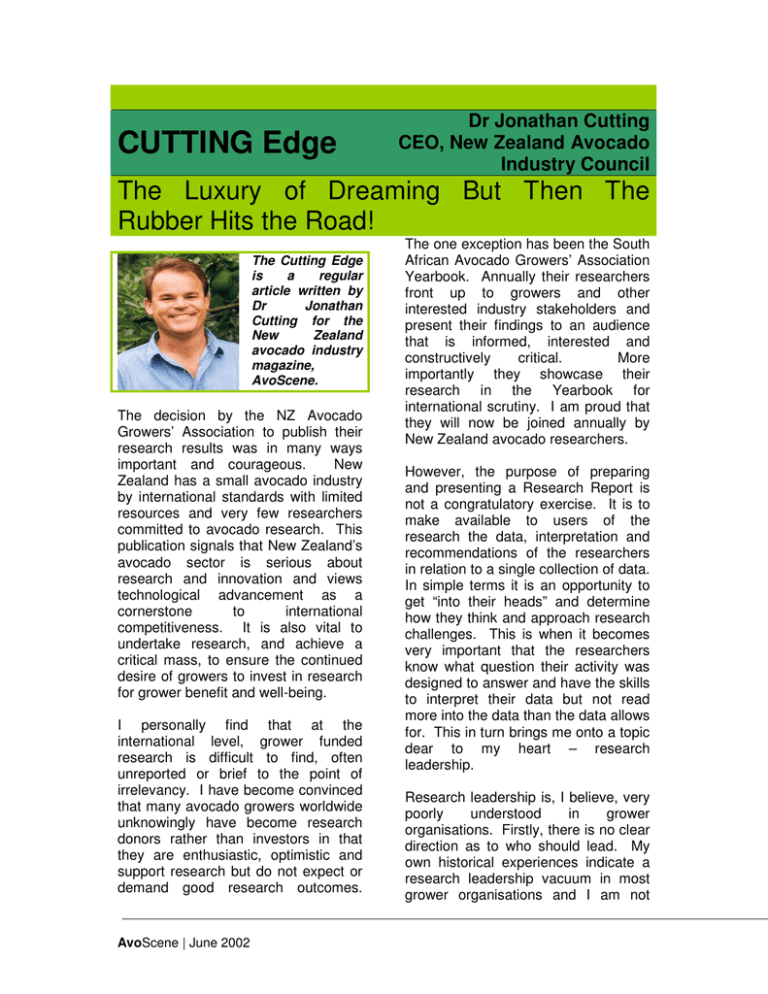
CUTTING Edge Dr Jonathan Cutting CEO, New Zealand Avocado Industry Council The Luxury of Dreaming But Then The Rubber Hits the Road! The Cutting Edge is a regular article written by Dr Jonathan Cutting for the New Zealand avocado industry magazine, AvoScene. The decision by the NZ Avocado Growers’ Association to publish their research results was in many ways important and courageous. New Zealand has a small avocado industry by international standards with limited resources and very few researchers committed to avocado research. This publication signals that New Zealand’s avocado sector is serious about research and innovation and views technological advancement as a cornerstone to international competitiveness. It is also vital to undertake research, and achieve a critical mass, to ensure the continued desire of growers to invest in research for grower benefit and well-being. I personally find that at the international level, grower funded research is difficult to find, often unreported or brief to the point of irrelevancy. I have become convinced that many avocado growers worldwide unknowingly have become research donors rather than investors in that they are enthusiastic, optimistic and support research but do not expect or demand good research outcomes. AvoScene | June 2002 The one exception has been the South African Avocado Growers’ Association Yearbook. Annually their researchers front up to growers and other interested industry stakeholders and present their findings to an audience that is informed, interested and constructively critical. More importantly they showcase their research in the Yearbook for international scrutiny. I am proud that they will now be joined annually by New Zealand avocado researchers. However, the purpose of preparing and presenting a Research Report is not a congratulatory exercise. It is to make available to users of the research the data, interpretation and recommendations of the researchers in relation to a single collection of data. In simple terms it is an opportunity to get “into their heads” and determine how they think and approach research challenges. This is when it becomes very important that the researchers know what question their activity was designed to answer and have the skills to interpret their data but not read more into the data than the data allows for. This in turn brings me onto a topic dear to my heart – research leadership. Research leadership is, I believe, very poorly understood in grower organisations. Firstly, there is no clear direction as to who should lead. My own historical experiences indicate a research leadership vacuum in most grower organisations and I am not limiting this to avocados. I make this claim because research leadership is most often passed onto research committees, which tend to be very tactical, subject to pressure, responsive to “this week’s issues” and most unfortunately generally not well skilled (this is a specialist business). Generally there are no overall arching research goals and strategies and if there are goals then there are no clear and understandable plans (strategies) as to how to achieve them (many people have visions as to what they want but no clear strategy as to how to achieve their wants). The result is a leadership vacuum into which researchers have unfortunately grown and filled the space. In my opinion “visionaries” tend to make poor leaders and we definitely need to understand the difference between leadership and leading. However, researchers are “foot soldiers” and are almost always focussed on their own issues such as their own research programme, their own postgraduate students, their own discipline, their own research antagonists, their own research network and their “friends” within industry. Clearly not a recipe for leadership of someone else’s business. In many ways it is expecting battlefield soldiers to make strategic war decisions – this is not their role, this is the role of the generals! Grower organisations need their research “generals” (leaders). These leaders should understand research, have clear goals with plenty of stretch and develop transparent plans as to how to achieve the goals. This will free up the researchers to do what they should do best – carry out research and allow them to specialise in technique and interpretation rather than politics and procurement. AvoScene | June 2002 A fundamental of successful leadership and thereby research delivery to investors is clear and coherent strategy (planning). This is an activity you can almost never do too much of. Research is a continuum, and responds poorly to a stop start approach. Part of the planning process is developing delivery vehicles for achieving good research outcomes. This can and does take many years. The investment in capability is poorly understood by growers who would rather see production (research project outcomes) rather than assist in infrastructure development (the vehicles to achieve the outcomes). Unfortunately the two are irrevocably interlinked. The disappointment is that the delivery vehicles in New Zealand have become progressively slower, heavy on gas (expensive), subject to breakdown (less reliable) and are now being fixed with less expensive parts (redundancies, staff turnover and lack of experience in core areas). Delivery vehicles have been a key concern for the AGA for almost a decade. This has coincided with the restructuring of New Zealand science where the result has been the development of new jargon rather than the knowledge economy. So what is the AGA doing? First, the AGA has planned extensively. It has strategies to enlarge the science/ researcher pool through developing a range of linkages and alliances with less traditional providers. There has been a strong plan to foster relationships with offshore organisations and academics and to engage in knowledge gathering by attending overseas conferences and sharing research information. The AGA has a comprehensive library small but (an open resource to all industry stakeholders) and has invested heavily in information gathering using new technology such as web based searches and electronic abstracting. Over the past two years the AGA has commissioned a small purpose developed laboratory suitable for postharvest research. This laboratory has been used this past year for maturity and fruit quality research. Second, we understand that science and research is about people, good people, where more is not at all correlated with better. We are identifying and dealing with people with unusual skill sets, a combination of ideas (intellectual “horsepower”), technical proficiency and experience. High staff turnover in third party provider institutions will not serve our needs neither now nor in the future. The AGA and AIC have therefore, cautiously but deliberately, started to invest in technical people to ensure capture and continuity. The first industry employed fulltime researcher will be appointed this winter using Foundation for Science and Technology funds. This person will become part of the “team” at the AGA/AIC offices (note there is no “i” in the word team) and will be required to deliver a return on investment. This is indeed a time of excitement and challenge……….. but we must not neglect research governance and very importantly research leadership otherwise we will be no better than what we are trying to avoid or improve and as we all know – two wrongs don’t make a right. AvoScene | June 2002

